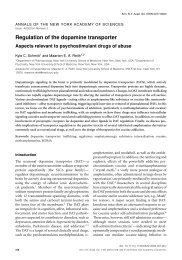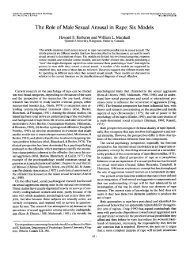How does stress increase risk of drug abuse - Addiction Research ...
How does stress increase risk of drug abuse - Addiction Research ...
How does stress increase risk of drug abuse - Addiction Research ...
Create successful ePaper yourself
Turn your PDF publications into a flip-book with our unique Google optimized e-Paper software.
346<br />
Prevalence <strong>of</strong> anxiety and mood disorders and behavioral<br />
conduct problems in adolescents is associated with<br />
an <strong>increase</strong>d frequency and regular use <strong>of</strong> substances<br />
such as alcohol, nicotine and marijuana (King et al.<br />
1996; Rohde et al. 1996; Kandel et al. 1997, Riggs et al.<br />
1999; Rao et al. 1999). Psychiatric and substance use<br />
disorders are highly co-morbid in adults as well, with<br />
lifetime prevalence rates above 50% for co-occurrence<br />
<strong>of</strong> any psychiatric disorder with substance <strong>abuse</strong> (Regier<br />
et al. 1990; Kessler et al. 1994, 1996). Increased frequency<br />
<strong>of</strong> substance <strong>abuse</strong> is more likely to follow the<br />
occurrence <strong>of</strong> behavior problems and psychiatric disorders<br />
(Kessler et al. 1996; Rohde et al. 1996; Riggs et al.<br />
1999). It has been postulated that psychiatric disorders<br />
such as anxiety and affective disorders are manifestations<br />
<strong>of</strong> chronic <strong>stress</strong> states that are associated with dysregulated<br />
brain <strong>stress</strong> circuits (Plotsky et al. 1995;<br />
Arborelius et al. 1999). It is possible that such neuroadaptations<br />
in brain <strong>stress</strong> circuits may lead to a greater<br />
sensitivity to the reinforcing properties <strong>of</strong> <strong>drug</strong>s in those<br />
vulnerable to <strong>drug</strong> <strong>abuse</strong>, thereby increasing the frequency<br />
<strong>of</strong> <strong>drug</strong> use in these individuals. Consistent with this<br />
hypothesis, Covington and Miczek (2001) have reported<br />
that chronic exposure to social defeat <strong>stress</strong> in laboratory<br />
animals <strong>increase</strong>d cocaine self-administration during cocaine<br />
binge episodes.<br />
Acute behavioral <strong>stress</strong> <strong>increase</strong>s <strong>drug</strong> use<br />
and <strong>drug</strong> seeking<br />
Exposure to acute behavioral <strong>stress</strong> facilitates selfadministration<br />
<strong>of</strong> amphetamines (Piazza et al. 1990;<br />
Piazza and Le Moal 1996), morphine (Alexander et al.<br />
1978; Hadaway et al. 1979; Shaham and Stewart 1994)<br />
and cocaine (Ramsey and Van Ree 1993; Goeders and<br />
Guerin 1994; Haney et al. 1995; Miczek and Mutschler<br />
1996). In contrast to these facilitative effects <strong>of</strong> <strong>stress</strong> on<br />
<strong>drug</strong> self-administration, research on the effects <strong>of</strong><br />
<strong>stress</strong> on alcohol consumption have been inconsistent.<br />
For example, alcohol consumption in response to <strong>stress</strong><br />
has been found to <strong>increase</strong> (Anisman and Waller 1974;<br />
Volpicelli and Ulm 1990), decrease (van Erp and Miczek<br />
2001) or not change (Myers and Holman 1967; Fidler<br />
and Lolordo 1996). These differences in findings have<br />
been attributed to several factors such as pre-<strong>stress</strong><br />
alcohol consumption levels, timing and exposure to<br />
<strong>stress</strong> and differences in type <strong>of</strong> <strong>stress</strong> manipulation<br />
(Wolfgramm 1990; Wolfgramm and Heyne 1991;<br />
Pohorecky et al. 1995; van Erp and Miczek 2001). <strong>How</strong>ever,<br />
using the <strong>stress</strong>-reinstatement paradigm, several<br />
studies have demonstrated that exposure to brief footshock<br />
<strong>stress</strong> reinstated <strong>drug</strong> seeking behavior after extinction<br />
trials in animals dependent on heroin, cocaine,<br />
alcohol and nicotine (Shaham and Stewart 1995; Erb<br />
et al. 1996; Ahmed and Koob 1997; Le et al. 1998;<br />
Mantsch and Goeders 1998; Shaham et al. 1998; Buczek<br />
et al. 1999). Therefore, while the facilitative effects <strong>of</strong><br />
<strong>stress</strong> on stimulant and heroin self-administration are<br />
well demonstrated, the effects <strong>of</strong> <strong>stress</strong> on alcohol consumption<br />
appear to be suppressive. Nonetheless, the<br />
<strong>stress</strong>-reinstatement studies have consistently shown that<br />
foot-shock <strong>stress</strong> <strong>increase</strong>s <strong>drug</strong>-seeking behavior in dependent<br />
animals. It may well be that the mechanisms that<br />
underlie the facilitative effects <strong>of</strong> <strong>stress</strong> on stimulant<br />
self-administration and the suppressive effects <strong>of</strong> <strong>stress</strong><br />
on alcohol self-administration are different from those<br />
that underlie <strong>stress</strong>-induced reinstatement <strong>of</strong> <strong>drug</strong> seeking<br />
behavior.<br />
Early evidence from human laboratory studies also<br />
found <strong>increase</strong>d <strong>drug</strong> taking after <strong>stress</strong> as opposed to<br />
non-<strong>stress</strong> situations. In social drinkers, exposure to<br />
<strong>stress</strong>ors such as fear <strong>of</strong> interpersonal evaluation, anger<br />
due to provocation by a confederate and failure feedback<br />
on exposure to insolvable problems, led to <strong>increase</strong>d alcohol<br />
consumption as compared to drinking behavior in<br />
non-<strong>stress</strong>ful situations (Higgins and Marlatt 1975;<br />
Marlatt et al. 1975; Hull and Young 1983). Other research<br />
has shown that parents exposed to child confederates<br />
exhibiting deviant externalizing behaviors, as compared<br />
to normal behaviors, consume significantly more<br />
alcohol (Lang et al. 1989; Pelham et al. 1997). Alcoholics,<br />
as compared to non-alcoholics, are also known to <strong>increase</strong><br />
alcohol intake in response to <strong>stress</strong>ful situations<br />
(Miller et al. 1974), and in smokers, smoking <strong>increase</strong>s<br />
after exposure to high anxiety as compared to low<br />
anxiety provoking situations (Pomerleau and Pomerleau<br />
1987). These findings indicate that in social drinkers,<br />
smokers and alcoholics, <strong>stress</strong> exposure enhances <strong>drug</strong><br />
self-administration.<br />
In light <strong>of</strong> these findings, preclinical studies have examined<br />
specific aspects <strong>of</strong> the <strong>stress</strong> response that facilitate<br />
<strong>drug</strong> self-administration. Activation <strong>of</strong> brain <strong>stress</strong><br />
circuits (i.e. CRF activation and subsequent <strong>increase</strong>s in<br />
adrenocorticotrophic hormone (ACTH) and cortisol (glucocorticoids),<br />
catecholamines co-released with CRF and<br />
opioid release) is known to <strong>increase</strong> dopaminergic neurotransmission<br />
in mesolimbic regions (Thierry et al.<br />
1976; Dunn 1988; Kalivas and Duffy 1989; Prasad et al.<br />
1995; Piazza and Le Moal 1996). The mesocorticolimbic<br />
dopaminergic system is believed to make up the brain reward<br />
pathways, and <strong>increase</strong>d dopaminergic transmission<br />
in these pathways is critical for the reinforcing<br />
properties <strong>of</strong> abusive <strong>drug</strong>s (Roberts et al. 1980; Taylor<br />
and Robbins 1984; Di Chiara and Imperato 1988; Koob<br />
and Le Moal 1997). Thus, <strong>stress</strong> co-activates brain <strong>stress</strong><br />
circuits and the putative reward circuitry simultaneously,<br />
thereby providing a common neural substrate by which<br />
<strong>stress</strong> may enhance the <strong>drug</strong> taking experience and <strong>increase</strong><br />
self-administration.<br />
Stress-induced <strong>increase</strong>s in cortisol levels have also<br />
been associated with enhanced self-administration <strong>of</strong><br />
psycho-stimulants such as cocaine and amphetamines<br />
(Piazza et al. 1990; Goeders and Guerin 1996; Piazza<br />
and Le Moal 1996; Mantsch et al. 1998) and alcohol<br />
(Fahlke et al. 2000). Elimination <strong>of</strong> the cortisol response<br />
by adrenalectomy, by treatment with metyrapone, a cortisol<br />
synthesis blocker, or by ketoconazole, a glucocorti-










